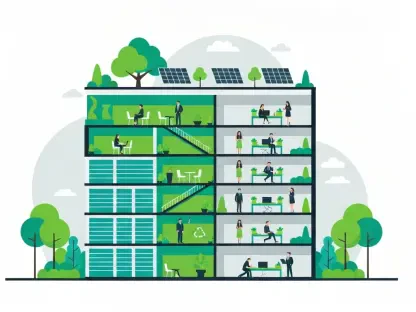The global data center construction market is witnessing unprecedented growth fueled by the rapid expansion of digital demands and technological advancements. This evolution is primarily driven by the need to enhance infrastructure capabilities to accommodate burgeoning workloads in artificial intelligence (AI) and machine learning. As organizations worldwide pivot towards integrated, high-tech solutions, their reliance on efficient and robust data management is inevitably escalating. Additionally, increasing digitalization across industries necessitates well-designed data infrastructure that can effectively handle mounting data loads and ensure seamless digital operations. This rapidly evolving scenario underscores the paramount importance of investing in state-of-the-art data centers, as these facilities form the backbone of the modern digital economy. As a result, companies across the globe are channeling substantial investments into data center construction, aiming to bolster their technological capabilities in these transformative times.
Market Growth and Forecast
The global data center construction market is on an exponential trajectory, with investments projected to surge to $214.16 billion by 2030. This growth is facilitated by an impressive compound annual growth rate (CAGR) expected at 15.15% over the upcoming years. As the demand for comprehensive and efficient data management solutions proliferates, companies are keen on developing cutting-edge infrastructures that encapsulate this progression. The increasing complexity of digital frameworks necessitates advanced data centers that can securely store, process, and deliver vast datasets. Amid this expansion, financial allocations are being thoughtfully administered to ensure long-term operational benefit and sustainability of these pivotal developments. As the digital landscape continues evolving, catering to heightened expectations in both speed and efficiency, investing in modernized data centers becomes indispensable. Furthermore, organizations recognize the urgency to adapt to these dynamics, reinforcing their drive to invest in state-of-the-art facilities and stay ahead in the competitive digital marketplace. This awareness highlights the crucial role of data center construction within contemporary business strategy.
Key Trends Driving Growth
Several key trends are fueling the expansion of the data center construction market. One prominent trend is the surge in reliance on digital services, which in turn catalyzes substantial investments in infrastructure. Companies are prioritizing new data center constructions to meet the growing need for resources that can sustain complex digital services. Parallel to this digital surge is an evolving shift towards sustainable practices. In recent years, operators have increasingly integrated renewable energy sources and energy-efficient technologies into their designs. This shift reflects a broader consensus on reducing the environmental impact of sprawling data infrastructures. Companies are not just building more infrastructure but are focusing on building smarter, greener facilities. These initiatives align with the global push towards sustainability, marking a significant step in integrating ecological considerations into technological developments. Moreover, with sustainability becoming a pivotal factor in infrastructure planning, these practices also contribute to a company’s corporate responsibility and public image, fostering a holistic approach to growth.
Regional Insights
In North America, the data center construction sector maintains a dominant position, with substantial investments funneled into the United States and Canada. High-profile regions like Northern Virginia and Texas have become epicenters for hyperscale operations involving leading players such as AWS, Google, and Microsoft. The allure of North America is further augmented by Canada’s strategic advantages, including low electricity costs and supportive government policies, concentrating activities in regions like Quebec and Toronto. Meanwhile, Asia Pacific is establishing itself as an emerging powerhouse in data center construction, marked by aggressive investment strategies in China, India, and Singapore. Countries in Southeast Asia, including Malaysia and Indonesia, are experiencing significant growth propelled by advancements in cloud services and AI. Companies like Equinix and Digital Realty are pivotal in this regional evolution, contributing to the Asia-Pacific region’s ascent as a formidable hub of data center operations. These regional dynamics underscore the need for tailored strategies to leverage regional strengths effectively in building global data center infrastructure.
Europe, on the other hand, is experiencing a notable shift towards secondary markets. Spain and Italy are garnering substantial investments, previously concentrated in more traditional European hubs. The Nordic region, characterized by its naturally cooler climate conducive to energy-efficient operation, continues to attract attention from hyperscale operators looking to optimize energy use. These developments signify Europe’s transition towards more diversified investment locales that promise cost-effectiveness and efficiency. Likewise, Latin America is undergoing a dynamic transformation as both established contractors and new entrants fuel growth. Central Eastern Europe, the Middle East, and Africa are also witnessing an expansion in data center construction projects, bolstered by strategic geographic locations and expanding digital landscapes. These regions are ideally poised to capture emerging market opportunities, given their advantageous positioning and aim to harness technology for economic advancements. Overall, the regional diversification observed across the globe represents a significant stride toward meeting diverse digital demands while maximizing regional capabilities.
Industry Players and Developments
The data center construction market includes a diverse array of players, from established firms to recent entrants. In North America, the market experiences a concentrated influx of investments from hyperscale operators facilitated by construction firms like AECOM, Jacobs, and Arup, which are pivotal to infrastructure development. Western Europe relies on companies such as Arup and AECOM, which benefit from substantial investments by Equinix and Digital Realty, driving significant advancements in data center development. This framework highlights the collaborative endeavors between construction firms and tech companies seeking efficient infrastructure solutions that support rapid advancements in digital technology. Across Asia Pacific, firms like GDS Services and Equinix play transformative roles, actively contributing to the region’s burgeoning presence in the global market. The roles of major vendors extend beyond construction to include providing sustainability-focused infrastructure and essential logistical support. Their integrated approach showcases the increasingly interconnected ecosystem encompassing technology, sustainability, and infrastructure in shaping the future trajectory of data center construction.
Emphasis on Sustainability
Sustainability is increasingly at the core of the data center construction narrative. Operators prioritize renewable energy integration and the adoption of energy-efficient technologies in line with global sustainability objectives. There’s growing consensus on minimizing the environmental footprint of expansive data infrastructure, evidenced by commitments to zero-carbon initiatives and other eco-friendly measures. These endeavors are instrumental in aligning data center construction with broader environmental conservation goals. Furthermore, innovative design approaches focus on enhancing operational efficiency while maintaining compliance with stringent environmental standards. With global regulations progressively emphasizing sustainability, the industry is adapting to incorporate eco-conscious elements into its strategic blueprint. This trend not only fulfills regulatory requirements but also establishes sustainable practices as a competitive advantage in business planning. As environmental consciousness transcends boundaries, investment in green technologies becomes imperative for new developments, fostering a resilient digital infrastructure that aligns with evolving global imperatives.
Technological Adoption and Infrastructure
Technological advancements are central to enhancing data center operational efficacy. Modern data centers innovate through adopting cutting-edge technologies that guarantee seamless operations and optimal functionality. The market’s investment segmentation spans facilities like hyperscale data centers catering to exponential data loads and enterprise data centers serving specialized business needs. Key infrastructure components include electrical elements like UPS systems, generators, and power distribution units, alongside mechanical infrastructure focused on cooling systems and ancillary equipment. Cooling technologies, employing methods like CRAC units and air-based cooling, are essential for maintaining optimal environmental conditions within the centers. Additionally, new constructions include general development aspects like core shell systems, engineering, security installations, and service reliability standards ranging from Tier I to Tier IV. These technological deployments are manifesting in advanced solutions that align architecture with a potent mix of reliability, scalability, and efficiency. As the market evolves, emphasis on integrating innovative technological capabilities remains pivotal for future-proofing data center infrastructure. These investments prepare companies for an increasingly digital future dominated by complex technological demands and escalating performance standards.
Market Potential and Future Landscape
Despite challenges inherent in technological adoption and initial investment costs, the data center construction sector presents promising prospects for innovative breakthroughs and growth. The anticipated market growth is buoyed by upward trends in market size, sophisticated infrastructure evolution, and enhanced power capacities. With projections indicating a significant increase in total area coverage and power capacity by 2030, there’s considerable optimism in cultivating infrastructure tailored to evolving digital demands. As the industry navigates potential hurdles, such as cost barriers and technological integration complexities, companies are expected to double down on innovation-driven pathways. Strategically invested efforts focus on complementing digital industry specifics and meeting global standards. Driven by a penchant for ingenuity and responsiveness, these advancements ensure data centers remain essential instruments supporting global digital expansion. As such, the market’s flourishing potential reflects a deeper, more nuanced commitment to enduring technological and infrastructural progressiveness.
Strategic Next Steps
In North America, data center construction is booming, with significant investments directed toward the U.S. and Canada. Northern Virginia and Texas are key regions attracting hyperscale operations from major players like AWS, Google, and Microsoft. Canada’s appeal is enhanced by low electricity costs and government support, focusing activities in Quebec and Toronto. Meanwhile, Asia Pacific is emerging as a strong contender in data center development, with China, India, and Singapore leading aggressive investment initiatives. Southeast Asian countries such as Malaysia and Indonesia are also experiencing substantial growth due to advancements in cloud technologies and AI. Companies like Equinix and Digital Realty play crucial roles in this regional growth, positioning Asia Pacific as a major hub for data centers.
In Europe, there’s a shift toward secondary markets, with increased investments in Spain and Italy, moving away from traditional hubs. The Nordic region is favored for its cool climate, which enhances energy efficiency, drawing interest from hyperscale operators. This reflects Europe’s broader trend of diversifying investment in more cost-effective locations. Latin America is also evolving dynamically, driven by both established contractors and new players. Meanwhile, Central Eastern Europe, the Middle East, and Africa are expanding their data center projects, thanks to strategic locations and growing digital needs. Overall, this global diversification reflects a strategic approach to meeting digital demands by leveraging regional strengths.









